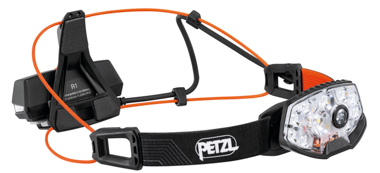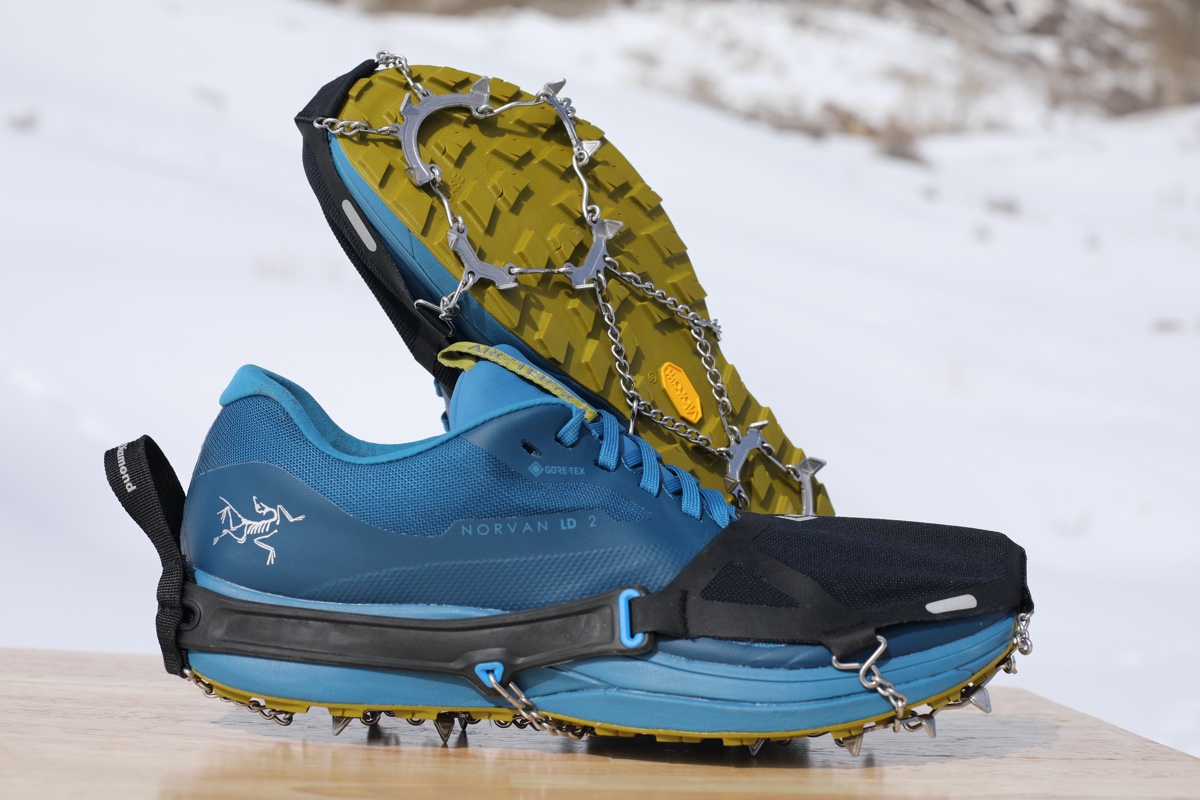Mountain running takes the best of trail running and ultrarunning and adds adventure, some mystery, and a lot of variety. Mountain running is a game for your imagination — you can find inspiring places, dream up routes, and discover ways you might navigate them.
Whether you’re lured to the iconic peaks of Chamonix or looking to get out on your local ridgeline, having the best mountain running gear can enhance your experience and help you move through the mountains safely and efficiently. Mountains provide unique challenges, including high elevations, volatile weather, route-finding, often spotty cell service, and much more, and it’s important to travel through them as prepared as possible.
A good rain jacket, like the Patagonia Storm Racer Jacket, is critical for safety, and you’ll want gear that can protect you from the elements. We frequently turn to the Ultimate Direction Ultra Flip Glove and Smith Motive sunglasses to protect our hands and eyes, and we carry the Petzl Nao RL in case we get caught out in the dark.
This guide offers a selection of the best gear from the iRunFar team’s broad and diverse mountain running experience in many locations across several continents.
Best Mountain Running Gear
- Best Mountain Running Shoes: La Sportiva Cyklon
- Best Hydration Pack: Salomon Adv Skin 12
- Best Waistbelt: Naked Running Band
- Best Trekking Poles: Black Diamond Distance Carbon Z Trekking /Running Poles
- Best Rain Jacket: Patagonia Storm Racer Jacket
- Best Windbreaker Jacket: Patagonia Houdini
- Best Shirt: Rab Sonic LS Zip
- Best Wind or Rain Pants: Patagonia Wind Shield Pants
- Best Gloves: Ultimate Direction Ultra Flip Glove
- Best Insulated Jacket: Montane Fireball Nano Hooded Jacket
- Best Headband: Crazy Idea Band Fast Cut Thermo
- Best Headlamp: Petzl Nao RL
- Best GPS Watch: Coros Vertix 2S
- Best Brimmed Hat: Janji AFO Hyperlight Cap
- Best Sunglasses: Smith Motive
- Best Water Filter: Katadyn BeFree 0.6L
- Best Traction Device: Black Diamond Distance Spike
Best Mountain Running Shoes: La Sportiva Cyklon ($185)
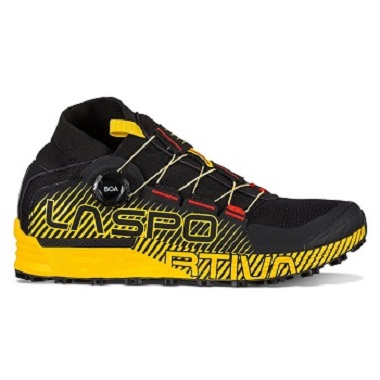 In 2002, La Sportiva trademarked the term “mountain running,” so the La Sportiva Cyklon should make the cut in this guide. It is snappy enough for fast ascents and has a lug configuration that shines on loose descents.
In 2002, La Sportiva trademarked the term “mountain running,” so the La Sportiva Cyklon should make the cut in this guide. It is snappy enough for fast ascents and has a lug configuration that shines on loose descents.
Taking the Cyklon to the mountains, the focus is on footwork and agility. Despite the aggressive lug pattern, the Cyklon lacks a rock plate and provides a lot of ground feel. The shoe feels very snappy and downright springy when jumping and landing over jagged rock and other obstacles. The incredible ground feel helps ensure solid footing over loose mountain terrain.
The Cyklon is a burly shoe indeed, and its upper is more durable than meets the eye, but it’s worth considering the duration and type of mountain running you expect. It’s not a cruiser for long runs or the most comfortable on hard ground. But when it comes to picking a short line to ascend and descend with reckless abandon, it is incredibly secure and confident.
If you love technical trails but haven’t liked the too-narrow La Sportiva shoe models in the past, you’ll be happy to know the Cyklon is very accommodating in the midsole, and the shoe works for many different foot shapes. The BOA Fit System dial works expertly to lock in the fit but may detach from the shoe if jammed against a rock. It’s happened to me a few times, but the BOA reattaches easily with little issue.
Read our La Sportiva Cyklon review to learn more.
Shop the Men's La Sportiva CyklonShop the Women's La Sportiva Cyklon
Best Hydration Pack: Salomon Adv Skin 12 ($165)
 The Salomon Adv Skin 12 is one of Salomon’s larger vests, with 12 liters of space to fit many layers and all the essential gear you need for long days in the mountains. It has convenient loops on the base of the pack so you can stash a pair of collapsible trekking poles. However, despite the capacity, it remains a light, low-profile pack that fits the body well even when nearly empty. This low-profile design allows you to wear the pack both over or under a shell jacket to keep your water, food, and phone from getting wet in a rainstorm. Salomon does a great job keeping its hydration packs light, even those with ample storage like this one. This pack is our top choice for a large running pack in our best running vests guide due to its comfortable fit, extensive pockets, and ability to carry everything we need for a big day out.
The Salomon Adv Skin 12 is one of Salomon’s larger vests, with 12 liters of space to fit many layers and all the essential gear you need for long days in the mountains. It has convenient loops on the base of the pack so you can stash a pair of collapsible trekking poles. However, despite the capacity, it remains a light, low-profile pack that fits the body well even when nearly empty. This low-profile design allows you to wear the pack both over or under a shell jacket to keep your water, food, and phone from getting wet in a rainstorm. Salomon does a great job keeping its hydration packs light, even those with ample storage like this one. This pack is our top choice for a large running pack in our best running vests guide due to its comfortable fit, extensive pockets, and ability to carry everything we need for a big day out.
You can read more about the details of this pack in our complete Salomon Adv Skin 12 review.
Shop the Salomon Adv Skin 12Best Waistbelt: Naked Running Band ($55)
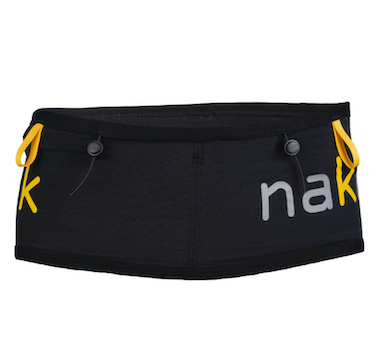 The Naked Running Band won iRunFar’s best overall waistbelt in our comprehensive best running belts guide, and it remains the best waistbelt of this kind. For mountain runs where you only need to carry a soft flask of water, some snacks, and a jacket, this belt is a lightweight option that will hold everything you need with minimal bounce. This belt also pairs easily with a running vest if you need extra storage capacity for long romps through the mountains.
The Naked Running Band won iRunFar’s best overall waistbelt in our comprehensive best running belts guide, and it remains the best waistbelt of this kind. For mountain runs where you only need to carry a soft flask of water, some snacks, and a jacket, this belt is a lightweight option that will hold everything you need with minimal bounce. This belt also pairs easily with a running vest if you need extra storage capacity for long romps through the mountains.
The stretchy, breathable, tube-style running waistpack has three deep pockets encircling the entire belt, with the largest one in the back, suitable to fit a full-size soft flask. The Naked Running Band has large elastic bands in which you can conveniently slip your running poles, though you might be able to feel them on the small of your back.
Thanks to its 12 sizes, the Naked Running Band has the most precise fit of all the tube-style running waistpacks. Some, but not all, testers found that the band’s tall height caused it to scrunch up around the abdomen. This depends on your body shape and how little you carry in the belt.
Shop the Naked Running Band
The Naked Running Belt has a high carrying capacity and sits nicely against the user’s body. Photo: iRunFar/Eszter Horanyi
Best Trekking Poles: Black Diamond Distance Carbon Z Trekking/Running Poles ($190)
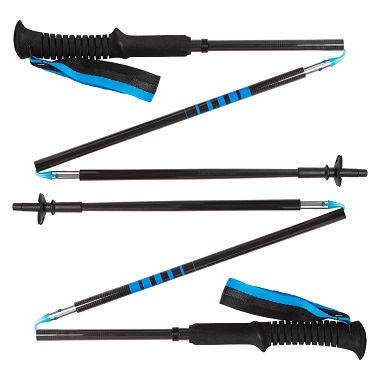 Collapsible, adaptable, and durable, the Black Diamond Distance Carbon Z Trekking/Running Poles have become ubiquitous for mountain runners and were the top pick in our best trekking poles guide. These poles come in sizes that accommodate a broad range of heights and boast a relatively low weight — the carbon-fiber construction amounts to 9 to 10.5 ounces per pair, depending on size. These are an excellent investment for runners tired of pushing on their knees with their hands to power up the steeps. They’re available in a variety of sizes, and there’s also a women’s version available that comes in even shorter lengths.
Collapsible, adaptable, and durable, the Black Diamond Distance Carbon Z Trekking/Running Poles have become ubiquitous for mountain runners and were the top pick in our best trekking poles guide. These poles come in sizes that accommodate a broad range of heights and boast a relatively low weight — the carbon-fiber construction amounts to 9 to 10.5 ounces per pair, depending on size. These are an excellent investment for runners tired of pushing on their knees with their hands to power up the steeps. They’re available in a variety of sizes, and there’s also a women’s version available that comes in even shorter lengths.
Some people hate using poles, and others swear by them. While a lot of terrain doesn’t necessitate their use, if you’re going out for a multiday mountain adventure or just a very steep one, using poles can preserve energy by reducing strain on your legs and keeping your body in better posture while moving uphill. These days, it’s rare to see anyone on the start line of a mountainous ultra without poles.
We appreciated the versatility of these poles. We could hook our wrists in the straps for increased power transfer on steep and sustained climbs, use the bottom part of the long foam handle when we wanted to effectively shorten the length of our poles, and lean on the tops of them for really steep descending.
The iRunFar team has used these poles for many years, and we’ve found that they’re incredibly durable and will last many years of hard, continuous use.
You can learn more about what we loved about these poles in our full Black Diamond Distance Carbon Z Trekking/Running Poles review.
Shop the Black Diamond Distance Carbon Z Trekking/Running PolesBest Rain Jacket: Patagonia Storm Racer Jacket ($300)
 There are many reasons the new Patagonia Storm Racer Jacket is currently our top rain jacket in the best rain jackets for running guide. Why? It checks most of the boxes we look for in an excellent running shell. First, for waterproofing, Patagonia employs its planet-friendly H2No technology, which is a totally recycled nylon ripstop fabric with a PFC/PFAS-free durable water-repellent (DWR) coating. We found the jacket to be highly waterproof as we took it on runs in multiple atmospheric river events and through wet snowfalls this winter in California.
There are many reasons the new Patagonia Storm Racer Jacket is currently our top rain jacket in the best rain jackets for running guide. Why? It checks most of the boxes we look for in an excellent running shell. First, for waterproofing, Patagonia employs its planet-friendly H2No technology, which is a totally recycled nylon ripstop fabric with a PFC/PFAS-free durable water-repellent (DWR) coating. We found the jacket to be highly waterproof as we took it on runs in multiple atmospheric river events and through wet snowfalls this winter in California.
The next thing we enjoyed about his jacket was its fit. The slim fit sits near the body without being overly tight. Instead of feeling bulky as some rain jackets do, the Storm Racer feels sleek and fast. Weighing just about 7 ounces (200 grams), this jacket is light enough to carry in a pack and forget bout it. It comes with a stash pocket that holds the entire jacket in a small volume, which we found ideal for carrying when it wasn’t raining. We frequently just stuffed it in a running vest without using the pocket.
Shop the Men's Patagonia Storm Racer JacketShop the Women's Patagonia Storm Racer Jacket
Best Windbreaker Jacket: Patagonia Houdini Jacket ($109)
 The Patagonia Houdini Jacket ticks all of the boxes of a good windbreaker. It is simple, packs down to next to nothing, stands up to rough mountain use, and is quite light while still providing solid protection against the wind. This jacket has been in the closets of iRunFar team members for years, and a look around the start line of any ultra will be a testament to its popularity. This jacket often lives in our packs as a just-in-case layer.
The Patagonia Houdini Jacket ticks all of the boxes of a good windbreaker. It is simple, packs down to next to nothing, stands up to rough mountain use, and is quite light while still providing solid protection against the wind. This jacket has been in the closets of iRunFar team members for years, and a look around the start line of any ultra will be a testament to its popularity. This jacket often lives in our packs as a just-in-case layer.
With few bells and whistles, this jacket is everything you need and nothing you don’t. Elastic on wrists keeps everything in place, and an adjustable toggle on the bottom hem lets you seal in heat if needed. The hood is large enough to wear over a helmet if you’re going scrambling or a warm hat if you’re out in the winter. It adjusts with a single toggle to stay put in windy conditions.
Patagonia says this jacket has a slim fit, but we didn’t find it to fit any tighter than most other wind jackets in our best windbreaker jackets guide. The back hem is a little longer than the front to provide extra protection. Made of 100% recycled nylon with a PFAS-free DWR coating; this jacket is yet another item from a brand committed to environmentally friendly manufacturing processes.
The material is a bit crinkly and can make a fair bit of noise in the wind, but it’s a small price to pay for what is otherwise an outstanding jacket that you can keep in your pack for any mountain outing. These are just a few reasons this jacket sits in our best running jackets guide.
Best Shirt: Rab Sonic LS Zip ($63)
 Rab is a traditional alpine climbing company from the U.K., and the Rab Sonic LS Zip is one of their recent forays into trail running-specific gear. Their gear captures some of the magic of the rounds and fells running scene found in their own backyard, and this ultra-lightweight half-zip shirt made with the latest, lightest fabrics is ideal for mountain outings.
Rab is a traditional alpine climbing company from the U.K., and the Rab Sonic LS Zip is one of their recent forays into trail running-specific gear. Their gear captures some of the magic of the rounds and fells running scene found in their own backyard, and this ultra-lightweight half-zip shirt made with the latest, lightest fabrics is ideal for mountain outings.
First, the long sleeves allow for thermoregulation. Roll them up when it’s warm on ascents, and pull them back down when descending. Second, the front zip adds excellent breathability and sweat control that a crew neck doesn’t offer.
The shirt has open-knit mesh panels under the arms, at the cuffs, and in the lower back to create exceptional moisture management and airflow right where you need it. Despite feeling notably lighter than most other long-sleeve shirts, it’s been warm enough for us on runs in the 30s and 40s Fahrenheit.
We reviewed the Rab Sonic LS Zip in greater detail in this Rab trail running apparel review.
Shop the Men's Rab Sonic LS ZipShop the Women's Rab Sonic LS Zip
Best Wind or Rain Pants: Patagonia Wind Shield Pants ($179)
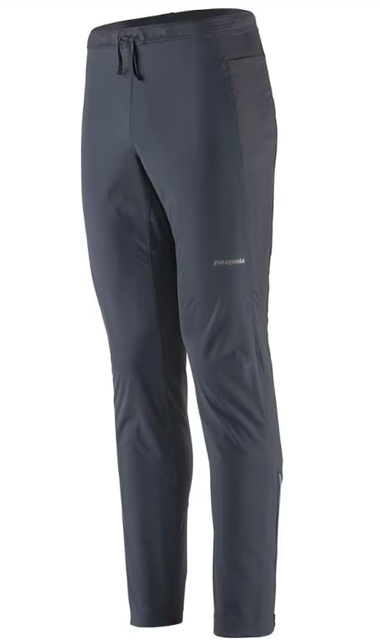 When running in cold, windy weather, we found that the Capilene Cool fabric of the Patagonia Wind Shield Pants kept us warm when temperatures dropped, and the wind picked up. These softshell pants are lightweight and stretchy and work well for temperatures hovering on either side of freezing. Breathable panels strategically located along the lateral legs and behind the knees help regulate temperature.
When running in cold, windy weather, we found that the Capilene Cool fabric of the Patagonia Wind Shield Pants kept us warm when temperatures dropped, and the wind picked up. These softshell pants are lightweight and stretchy and work well for temperatures hovering on either side of freezing. Breathable panels strategically located along the lateral legs and behind the knees help regulate temperature.
Because these pants have a bit of a generous cut, it’s possible to add some thin layers underneath for running in low temperatures. A set of tall socks and a pair of tighter running shorts can do a lot for added warmth. The cut of the pants allows for a full range of motion, and they’re comfortable to wear, providing the little bit of extra warmth that can make all the difference during a mountain run.
The waistband is wide, soft, and stretchy, and an external drawcord is easy to cinch down. With a small pocket on either side, these pants are ready to carry small items like keys, a headlamp, or extra gloves.
These pants are far from waterproof but do a reasonable job of shedding light moisture. The DWR coating helps water bead, but they will soak through in heavy precipitation. However, when it comes to cutting the wind, they perform admirably. At only 9.3 ounces, they’re easy to carry in a pack when you don’t need them.
You can read more about these pants in our Patagonia apparel review.
Shop the Men's Patagonia Wind Shield PantsShop the Women's Patagonia Wind Shield Pants
Best Gloves: Ultimate Direction Ultra Flip Glove ($40)
 Mountain weather can vary, and the Ultimate Direction Ultra Flip Glove provides versatility in handling all the coldest and wettest conditions. We’ve used this glove for pre-dawn chilly morning runs, multiday fastpacks through the San Juan Mountains, racing and FKT runs, and everything in between. We’re big fans of convertible gloves, and this was one of the first on the market and remains our favorite.
Mountain weather can vary, and the Ultimate Direction Ultra Flip Glove provides versatility in handling all the coldest and wettest conditions. We’ve used this glove for pre-dawn chilly morning runs, multiday fastpacks through the San Juan Mountains, racing and FKT runs, and everything in between. We’re big fans of convertible gloves, and this was one of the first on the market and remains our favorite.
The glove features a soft, warm, and comfortable grid fleece. It doesn’t have any added silicone or rubber, on the palms, so it can be slippery if you’re trying to hold on to something. Bits of rubber on the forefinger and thumb provide reasonable touchscreen capability.
The material offers a good amount of warmth and breathes well, so we rarely had issues with sweaty hands. The cuff extends far back on the wrist to provide extra coverage, though it does make it a bit of a wrestle to get the glove on and off if your hands are damp.
The overglove is a waterproof silicone-coated Cordura ripstop that stores on the back of the wrist when unused. It’s easy to pull out and put over the back of the hand, fingers, and thumb if the weather gets wet. It provides a lot of extra warmth and protection from rain. Since it doesn’t cover the palm, the inner glove will still get wet in significant downpours. One of our testers also found that that overglove would fill with water if she walked with her hands by her sides during a rain storm.
Still, these gloves’ versatility and warmth make them a top choice for nearly any mountain weather conditions. In our best running gloves guide, we’ve named them our favorite convertible option.
Best Insulated Jacket: Montane Fireball Nano Hooded Jacket ($240)
When running in the cold, it’s important to have an insulated jacket you can trust to keep you warm. The Montane Fireball Nano Hooded Jacket provides the right balance of warmth, breathability, and light weight, making it our go-to jacket when the weather gets cold.
With body-mapped insulation, this jacket provides warmth around the core where you need it and sheds heat in other areas. The recycled Dynamic Eco insulation is environmentally friendly and warm compared to synthetic insulation.
We loved this jacket’s light weight and the fact that it packs down into its own pocket, making it easy to store in a running pack. While it’s not great for runs with precipitation, it’s an excellent insulator for cold and dry days.
We found that this jacket ran a bit smaller than many others, so if you’re in between sizes, it’s worth sizing up.
This jacket is in our best running jackets guide for its combination of features.
Shop the Montane Fireball Nano Hooded JacketBest Headband: Crazy Idea Band Fast Cut Thermo ($30)
 Sometimes, you don’t need the full warmth of a hat, and the Crazy Idea Band Fast Cut Thermo headband protects the ears without causing overheating. “Crazy” is the shorthand way fans of this brand refer to it, and the full name “Crazy Idea” is accurate; they do things differently — much differently! From the incredible environmentally focused packaging to the prints and patterns of the fabric — check out their jeans for ski mountaineering! — this Italian brand offers a fresh perspective for mountain runners.
Sometimes, you don’t need the full warmth of a hat, and the Crazy Idea Band Fast Cut Thermo headband protects the ears without causing overheating. “Crazy” is the shorthand way fans of this brand refer to it, and the full name “Crazy Idea” is accurate; they do things differently — much differently! From the incredible environmentally focused packaging to the prints and patterns of the fabric — check out their jeans for ski mountaineering! — this Italian brand offers a fresh perspective for mountain runners.
Unlike a Buff-style tube, a headband is excellent for sun protection and hair control, as well as a sweat absorber or ear warmer — all the things you might require during a single day in the mountains. The 14-gram headband is even bacteriostatic, meaning it is soft, moisture-wicking, and bacteria-resistant. It’s available in many different patterns, and you’ll undoubtedly find one that suits your style.
Shop the Crazy Idea Fast Cut Thermo BandBest Headlamp: Petzl Nao RL ($180)
The Petzl Nao RL is an updated version of the Nao+, which ultrarunners have loved for many years. We featured it in our best running headlamps guide for many years because it combines battery life, ease of use, comfort, and brightness.
As with its predecessor, this headlamp offers regular and Reactive Lighting options. The Reactive Lighting grows dimmer when there’s more ambient light or brighter as needed. This can save a lot of battery and optimize the lighting for any ambient light conditions. The battery is not light, but it will give you a whole summer night of decently lit trail running. Switching batteries in the field is a relatively easy process.
The Nao RL also has a red light in the back that can be solid or a strobe to keep you visible to approaching cars or other runners. The reflective headband also improves the runner’s visibility to others.
While this isn’t the smallest headlamp, it can produce up to 1,500 lumens to help with route scouting in the dark. Its battery life is long enough that you won’t have to worry about it running out if you’re out for an extended period in the dark.
To read more about the features of this headlamp, check out our full Petzl Nao RL review.
Shop the Petzl Nao RL
The Petzl Nao RL can provide plenty of light for off-trail mountain navigation. Photo: iRunFar/Eszter Horanyi
Best GPS Watch: Coros Vertix 2S ($700)
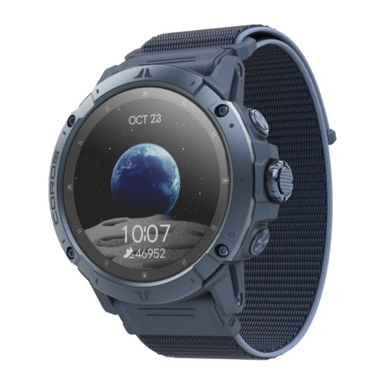 While countless GPS watches on the market will track and record your position and measure all of your health metrics, the Coros Vertix 2S stands out from the rest due to its incredible battery life. When we’re deep in the mountains, the last thing we want to worry about is our watch battery dying, and the 118 hours of full GPS use offered by this massive battery means that we never have to worry about it running out.
While countless GPS watches on the market will track and record your position and measure all of your health metrics, the Coros Vertix 2S stands out from the rest due to its incredible battery life. When we’re deep in the mountains, the last thing we want to worry about is our watch battery dying, and the 118 hours of full GPS use offered by this massive battery means that we never have to worry about it running out.
The rugged construction of this watch means that it’ll stand up to the elements in the mountains, and the 1.4-inch sapphire touchscreen is resistant to scratches. The titanium bezel feels fairly indestructible. There’s no denying that this watch is big and has the potential to dwarf the wrists of smaller people, but it’s not that much bigger than many other watches on the market these days. The large screen makes it easy to navigate the maps and see a lot of data screens at a glance.
Coros uses all five major satellite systems to determine location, more than most other watches. While this uses more battery and doesn’t provide a huge accuracy advantage in wide-open terrain, this GPS was more accurate in difficult locations, such as slot canyons with very little view of the sky or heavily forested areas. Compared to other watches, it picked up far fewer errant points after a day of wandering around Utah canyon country.
With the brand’s newest optical heart rate monitor on board, this watch provides some of the best wrist-based heart rate measurements available. While this isn’t necessarily a watch for the everyday urban runner, if you’re going deep into the mountains and valleys of the backcountry, this watch is worth the investment.
We’ve included this watch in our best GPS running watches guide, and you can learn more about it in our in-depth Coros Vertix 2S review.
Best Brimmed Hat: Janji AFO Hyperlight Cap ($38)
 Hats perform a variety of functions in the mountains. They keep the sun off our faces, protect our eyes from rain, provide cooling after being dipped in a stream, and more. The Janji AFO Hyperlight Cap is lightweight, comfortable, and adjustable so that it stayed on our heads in the windiest of conditions, making it an ideal option for long days in the mountains.
Hats perform a variety of functions in the mountains. They keep the sun off our faces, protect our eyes from rain, provide cooling after being dipped in a stream, and more. The Janji AFO Hyperlight Cap is lightweight, comfortable, and adjustable so that it stayed on our heads in the windiest of conditions, making it an ideal option for long days in the mountains.
Weighing a mere 29 grams, it’s incredibly light on the head and stashes easily into a pack when it’s not needed. The polyester and elastane blend dries quickly, and wicks sweat well. We never felt that our heads were overheating when wearing this hat.
While this hat’s brim isn’t as long as a traditional trucker hat, it still provides plenty of shade on the face. It also has the advantage of having less surface area to catch the wind when up on a ridgeline, reducing the chances of the hat flying off. A single bungee cord offers adjustability, so tightening the hat is easy when conditions get difficult.
We really liked the fit of this hat. It’s lower profile than many others on the market, and it also doesn’t scream “running hat,” so we could also wear it in casual settings before and after runs without feeling self-conscious. The combination of this hat’s appearance and functionality led us to place it at the top of our best running hats guide.
Best Sunglasses: Smith Motive ($175)
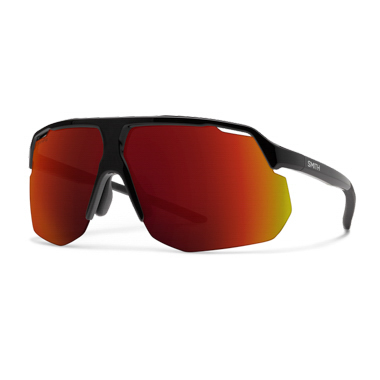 When running in the mountains, it’s important to protect your eyes from harmful UV rays, whipping wind, vegetation, and incoming precipitation, and the Smith Motive does an outstanding job on all of those fronts. These sunglasses have a fairly large wraparound lens that provides front and side protection and a frame that best fits medium-sized faces. While the entire package may be overpowering for some, and not necessarily for casual wear, these sunglasses are hard to beat when it comes to technical performance.
When running in the mountains, it’s important to protect your eyes from harmful UV rays, whipping wind, vegetation, and incoming precipitation, and the Smith Motive does an outstanding job on all of those fronts. These sunglasses have a fairly large wraparound lens that provides front and side protection and a frame that best fits medium-sized faces. While the entire package may be overpowering for some, and not necessarily for casual wear, these sunglasses are hard to beat when it comes to technical performance.
The Chromapop lenses provide exceptional optical clarity and increase contrast, making it easier to see details in the trail. You can choose the lens that best fits the conditions you run in the most often, and the sunglasses come with a clear lens to use in dark conditions.
We tested these sunglasses while running, skiing, and cycling and found they excelled in all conditions. They didn’t fog up and stayed on our faces, regardless of the rugged trail we were traversing. Weighing just 29 grams, it was easy to forget that we were wearing these glasses.
While these sunglasses are on the more expensive side of the range, we believe it’s worth investing in devices that optimize how you see the world. We found these glasses quite durable, and the lenses resisted scratches even when we accidentally dropped them.
We include these in our best running sunglasses guide, and you can read more about their features in our full Smith Motive review.

iRunFar’s Alli Miles wears the Smith Motive sunglasses during a mountain run on the California coast. Photo: iRunFar/Eszter Horanyi
Best Water Filter: Katadyn BeFree 0.6L ($40)
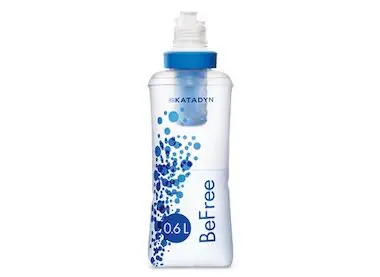 When the Katadyn BeFree 0.6L launched, it was the first filter that fit directly on a soft flask. It was a huge innovation for runners and backcountry travelers who didn’t want to carry around a cumbersome water filter. Being able to fill up water while out on a backcountry run was a game changer for many, and while there are many other similar products on the market these days, we still turn to the original for reliable and easy filtering.
When the Katadyn BeFree 0.6L launched, it was the first filter that fit directly on a soft flask. It was a huge innovation for runners and backcountry travelers who didn’t want to carry around a cumbersome water filter. Being able to fill up water while out on a backcountry run was a game changer for many, and while there are many other similar products on the market these days, we still turn to the original for reliable and easy filtering.
Using the filter is simple and speedy: In the backcountry, you fill the 0.6-liter soft flask with water and drink straight from the attached nozzle, stopping only for as long as it takes to fill the flask. The flask fits in many running vest pockets, and the filter will fit many of Hydrapak’s narrow-mouth flasks.
Our Katadyn BeFree 0.6L review has more details about this great product, which was the top pick in our best water filters for trail running guide.
Shop the Katadyn BeFreeBest Traction Device: Black Diamond Distance Spike ($100)
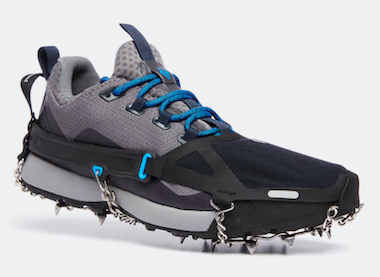 You might find snow and ice while mountain running, either traversing or ascending steep snow fields and snow gullies (or even moderate couloirs) or crossing glaciated terrain, and using a traction device like the Black Diamond Distance Spike can make movement safer and more efficient.
You might find snow and ice while mountain running, either traversing or ascending steep snow fields and snow gullies (or even moderate couloirs) or crossing glaciated terrain, and using a traction device like the Black Diamond Distance Spike can make movement safer and more efficient.
Using a crampon-like, chain-and-metal-spike system, the Distance Spike provides plenty of grip on a variety of different types of snow and ice. It cuts the weight of a traditional crampon roughly in half without compromising much on grip.
This is an easy-on, easy-off traction device built for mountain running. It stores easily in your pack, making it perfect for the moments you need it and not very noticeable when stowed.
To learn more about the Distance Spike, read our in-depth Black Diamond Distance Spike review and what we said about it in our best winter running traction devices guide.
Shop the Black Diamond Distance SpikeConsiderations for Mountain Running
Whether you’re heading out for a day run in your local mountain range that you’ve done dozens of times or tackling a multiday mountain traverse that you’ve been dreaming about and planning for months or years, running in the mountains is a special experience. Unlike many more traditional trail runs, mountain runs expose runners to the elements, take them to remote locations, and test their physical and mental fitness.
Mountain running often requires an extra skill set beyond normal trail running or ultrarunning. There are endless routes for mountain runs in ranges around the world. Whether you’re looking for a short and steep romp up the mountain behind a city or aiming to get days away from civilization during fastpacking trips, there are many options to choose from around many regions of the world.
Having the right gear, whether you need a traction device like the Black Diamond Distance Spike to negotiate snow or a windbreaker like the Patagonia Houdini Jacket that will stow away in your pack as a just-in-case layer, will make traveling in the mountains safer and more enjoyable.
If your mountain running involves overnight trips, you can learn more about our favorite gear in our best ultralight backpacking gear guide.

The right gear can make all types of mountain running safe and enjoyable. Photo: iRunFar/Eszter Horanyi
Safety Considerations for Mountain Running
Because many mountain runs take place in more remote locations, taking the proper safety precautions is even more important than if you were just going for a run on your local backyard loop. Regardless of where you’re running, telling someone where you’re going and when you’ll be back is always a good idea.
In addition to this info, it’s a good idea to tell your safety person when and how to raise the alarm if you’re not back within a certain amount of time from your expected return. Carrying an extra jacket, like the lightweight Patagonia Storm Racer Jacket, can increase your margin of safety in many situations.
Many mountain runners use a satellite communicator like a SPOT or a Garmin inReach to communicate, even if they are out of cell service. These devices are critical for summoning help if something happens, and they’re also useful for alerting a loved one if you’re running late so they don’t have to worry about you.
Mountain running often occurs at high altitudes, leading to safety concerns. As altitude increases, there’s less oxygen in the air for your body to use. If not acclimated to a certain altitude, a body won’t have the physiological adaptations to exert itself at normal levels. While in most circumstances, this just results in slower movement, altitude sickness can occur and be deadly. You can learn more about altitude-related issues at iRunFar’s Trail First Aid: Altitude Illness.
The best way to avoid severe altitude issues is to allow your body to adjust to high altitude slowly by not going from sea level to the high peaks without spending some time at moderate elevations in the process.
Essential Mountain Running Safety Gear
Because of the more technical terrain and often variable and potentially dangerous weather, mountain running usually carries greater risks, and access to help and/or medical attention can be more challenging. If you find yourself in more rugged terrain without easy access to services, it’s also worth considering packing some of the following items.
Navigation Tools
- Navigation app for phone
- Compass when needed
- Paper maps when needed
Emergency Essentials
- Emergency blanket
- Lighter/matches
- Wound dressing
- Medications (such as Benadryl or an EpiPen)
- Sunscreen
- Lube
- Bathroom kit (includes two ziplocks and a couple of pieces of toilet paper)
- Whistle
- Light source
Packing the safety equipment you’ll need for an unexpected night out is often a good idea. You don’t necessarily need to be comfortable if you get stuck out — you just need to be able to stay alive if forced to hunker down for a while.
Having a headlamp like the Petzl Nao RL will get you home in the dark if a run has gone longer than expected and save you from a night in the woods. A jacket, even if it’s something as light as the Patagonia Houdini Jacket, can make a big difference in survival.

iRunFar’s Meghan Hicks fastpacks through the Weminuche Wilderness in Colorado. Photo: iRunFar/Eszter Horanyi
Clothing Choices for Mountain Running
While running on well-established trails that are in cell service and well-traveled can require very little gear beyond a pair of shoes and a single layer of clothes, mountain running requires more preparation. Many mountain runs can take a person far from civilization and away from immediate help.
While it might be tempting to run without extra clothing with the thought that you’ll be able to outrun changing weather, it’s important to consider the consequences of being immobilized and needing to wait for help in a remote area. A runner might be able to stay warm in a single shirt and shorts as long as they can move, but if they have to stop and wait several hours for a rescue, hypothermia could set in quickly.
Mountain running clothing must be breathable and wicking to keep you dry and comfortable. Our team loved the Rab Sonic LS Zip as a base layer for all types of running conditions. Your clothing choices also need to consider the weather forecast and the potential for unexpected storms. Unlike local runs, where you can scurry home if the weather takes a turn for the worse, it’s a good idea to carry clothing that can protect you from the elements.
At a minimum, it’s a good idea to at least carry a light jacket, like the Patagonia Houdini Jacket, or a rain jacket, like the Patagonia Storm Racer Jacket, even for a short mountain run with a good weather forecast.
Navigation Essentials
In most circumstances, you won’t find trail maps at the intersections of trails during mountain runs, and it’s important to have the navigation skills and tools to keep from getting lost. Gone are the days when paper maps were the only option for navigating an area.
Now, many navigation apps can be used offline on a phone, such as Gaia and onX. Both allow you to download maps of an area ahead of time and plot your route on them. When you’re on the trails, they can pinpoint your location and make navigation easy.
If you’re using your phone as your primary navigation source, you’ll want to make sure it has plenty of charge for the task, and you may want to carry a backup battery. Phones can also break, or the mapping apps can crash unexpectedly, so a backup navigation plan is always a good idea. Many GPS watches, including the Coros Vertix 2S, have a decent base map loaded on them that you can use to get home if your primary form of navigation stops working.
In the end, it’s never a bad idea to have a compass, a basic map of the area, and a general idea of how to use them to get you home. It’s easy to carry navigation essentials in a pack like the Salomon Adv Skin 12, and a Naked Running Band can also fit a phone easily.

iRunFar’s Meghan Hicks turns to the Black Diamond Distance Carbon Z Trekking Running Poles for a run in the Colorado San Juan Mountains. Photo: iRunFar/Eszter Horanyi
Lightning Safety
Lightning is a very real danger faced by mountain runners. Mountain weather can change quickly, and thunderstorms can pop up out of seemingly nowhere. In places that experience monsoonal weather patterns, a bluebird morning can quickly deteriorate into massive thunderstorms in minutes. Checking the weather forecast and paying attention to the sky is important before and during a mountain run, whether going out for a few hours or several days.
Getting caught out above treeline during a thunderstorm is dangerous. Ideally, getting back into the trees as soon as the weather turns is the best chance to avoid a dangerous situation. Making good route decisions early can save a runner from a frantic sprint downhill. While lightning can also strike below treeline, a runner is in much more danger if they are the tallest object in an open alpine meadow or on top of a peak.
It’s possible to approximate how far away a lightning strike is by counting the seconds between seeing a lightning bolt and hearing the clap of thunder it creates. Every five-second increment between lightning and thunder is about equivalent to one mile. So, a 10-second gap between the lightning bolt and the thunder boom means the strike was about two miles away.
If you are caught in a lightning storm and can’t get to a lower elevation quickly, your best bet might be to get into the lightning position and wait it out. Read more about lightning safety and how to treat lightning-related injuries in iRunFar’s Trail First Aid Series. A good jacket, like the Patagonia Storm Racer Jacket, can make waiting out a storm safer, easier, and more comfortable.

Maggie Guterl scrambling during a mountain run in Colorado’s San Juan Mountains. Photo: iRunFar/Eszter Horanyi
Snow Safety
Many mountain running routes, especially in late spring or early summer, run into snow. Early fall snowstorms can also cover an area in snow and impede travel if you don’t have the right skills and gear to move through a region safely. Three major snow hazards include avalanches, slips and falls, and difficult navigation.
While most runners won’t find themselves traversing snow prone to avalanches, it’s good to know a few basics to make good decisions if you are out in the mountains and need to evaluate a snow slope. In the middle of winter, slab avalanches are most likely to occur on slopes steeper than 30 degrees. This is generally the terrain of skiers, but runners on snowshoes also need to be aware of their surroundings and not traverse across or below steep slopes.
As the snow starts to become firmer in the spring, runners may need to watch out for wet avalanches. These can occur on much shallower slopes when the sun has heated the snow and water has worked its way into the snowpack and destabilized it. If you’re sinking past mid-calf in soft snow in early spring, you want to stay away from steeper slopes.
Unstable snow also appears when pinwheels of snow roll down a slope. Both slab and wet avalanches can be deadly, and if you’re not sure about a slope, it’s probably a good idea to avoid it and find another route.
Slips and falls can turn dangerous when traveling on hard snow. If you lose your footing, it doesn’t take much of a slope to start sliding, and a long slide that ends in rocks can be dangerous. If you’re frequently traveling on hard snow, having traction devices in your pack is a good idea to assist with footing.
Our team found the Black Diamond Distance Spike an excellent option for additional traction. A pair of poles, like the Black Diamond Distance Carbon Z Trekking/Running Poles, can also help with stability on the snow.
Snow can also obscure the trail and make navigation difficult. If you travel in the mountains in early spring, you’ll need to be well-versed in navigation and expect snow cover in some areas.
Why Trust Us
The rest of the iRunFar editorial team has nearly more than 100 years of collective years of mountain running experience, and we’ve drawn on our mistakes and successes to create this guide. We’ve climbed as high as 19,000 feet into the mountains and trekked as far as 200 mountain miles in a single adventure. We’ve completed the Nolan’s 14 line in Colorado — an iconic mountain running line — in under 60 hours. We’ve summited peaks in all seasons and weather conditions.
Our team consists of avid fastpackers, scramblers, and people considering 12-hour outings as a “half-day” trip. All this to say, we travel far in the mountains and have made our fair share of errors when selecting gear. Our goal with this guide is to help you sort through the endless possibilities for essential mountain gear so that you can equip yourself with products that will perform in the most difficult of conditions.
Frequently Asked Questions About Mountain Running
What is mountain running?
Despite its obvious crossover with trail running, mountain running is a distinct sport. The World Mountain Running Association launched in the late 1980s, and mountain running became an official designation to distinguish the sport as a separate discipline. Since then, the annual international series has drawn top runners (and often crossover athletes like ski mountaineers) to its events.
This racing tradition has morphed into what most people consider mountain running today: variable terrain, often off-trail, and far from where the road ends. These events can be short, steep efforts or multiday adventures. For successful mountain running, it is vital to have a pair of shoes, like the La Sportiva Cyklon, that can handle an array of mountain conditions.
Though many mountain runners will incorporate scrambling or easy rock climbing into their route, this guide is for runners who might only encounter basic scrambling, such as using your hands to pull up over some rock sections, and not advanced scrambling or climbing, where steepness and exposure add consequence.
You might also encounter hazards and conditions that require specific knowledge while adventuring in the mountains, like glaciated terrain or avalanche conditions. While the Black Diamond Distance Spike will get you across many a snow slope, this guide doesn’t recommend gear for these more specific circumstances.
What is essential gear for mountain running?
Mountain running can be relatively involved in terms of gear requirements. Along a mountain run, one might encounter a range of terrain, from singletrack and talus fields to snowfields, glaciers, third-class rock, and more.
Additionally, mountain weather can be fickle, requiring a range of gear to provide safety and comfort. Mountain running often requires preparation for winter, even in the middle of summer! Even a light windbreaker jacket like the Patagonia Houdini Jacket can make a big difference if the weather turns bad.
You may check a mountain forecast beforehand and feel confident bringing just shoes, shorts, and a jacket. But in most cases, incorporating some of the products we’ve selected here will make your experience much better (and safer). Some team members refuse to go into the mountains without a headlamp, emergency blanket, and rain jacket, like the Patagonia Storm Racer Jacket, as their core safety gear.

The Patagonia Houdini Jacket has been a long-time iRunFar favorite for mountain running and fastpacking. Photo: iRunFar/Eszter Horanyi
Do I need poles for mountain running?
When it comes to moving fast over mountain terrain, many runners prefer using a set of running poles like the Black Diamond Distance Carbon Z Trekking/Running Poles. A set of poles can provide extra propulsion on uphills by engaging your arm muscles, increase stability on descents, and offer additional points of contact with the ground when traversing technical terrain.
Most trekking poles are easy to store in a hydration pack like the Salomon Adv Skin 12 when you’re not using them, and they’re light enough to carry, even if you’re not going to use them for the entire run.
Should I carry a first-aid kit?
Preparing for the unexpected is a good idea if you’re running in remote locations. A simple cut can ruin a run if you don’t have a way to stop the bleeding and keep it covered. Having a first-aid kit with a few bandages, antibiotic ointment, and some gauze can go a long way toward managing basic wounds.
You can learn more about would management and some essentials to carry in a mountain running first-aid kit here. A small first aid kit will fit easily into a pack like the Salomon Adv Skin 12.
What’s the best way to navigate during a mountain run?
There are countless ways to navigate an unknown area, with most mountain runners relying heavily on phone apps that can hold maps of the area and a route and pinpoint a location at any time. While phones are easy to carry, even in a small running belt like the Naked Running Band, they have limitations. Using your phone for navigation will significantly strain the battery and deplete it faster than normal.
The GPS function on a phone can also be off by several hundred feet and may fail to find a reliable signal if you’re in deep valleys or under a lot of tree cover. Lastly, none of the apps are bombproof and can occasionally lose their downloaded maps. It’s never a good idea to rely solely on your phone to get you home.
Doing research before heading out for a mountain run can help you have a general understanding of an area. If you have a mental map of where you’re trying to go and various landmarks to navigate by, you should be able to generally work your way through an area, even if you’re doing an off-trail route.
A backup paper map and compass can also get you home if your electronic navigation fails. The base maps on a watch like the Coros Vertix 2S can also help with navigation.

The large face of the Coros Vertix 2S makes it easy to see a variety of data fields at once. Photo: iRunFar/Eszter Horanyi
Do I need a satellite messenger to let people know where I am?
If you’re running in remote locations, especially if you’re running solo, it’s a good idea to have some sort of satellite messenger. Whether you carry a SPOT, which can send simple OK or SOS signals to family or summon search and rescue, or a Garmin inReach that will allow you to use the satellite network to send texts from your phone, these devices can provide you and your loved ones with some amount of peace of mind. They can also decrease the time and effort required by search and rescue if they need to perform a rescue.
Most satellite devices are fairly small and fit in a pack, such as the Salomon Adv Skin 12. And even if you never have to use it for yourself, there are countless instances where someone carrying a satellite device was able to use it to call for help for someone else that they found injured on the trail.
Do I need to filter water in the mountains?
While a mountain stream might look crystal clear and inviting to drink, it can carry many bacteria and viruses that can make you sick. Giardia is the most common waterborne bacteria that can lead to diarrhea, stomach cramps, and dehydration. It gets into waterways from mammals in the area and is impossible to detect with the naked eye.
Given how light and easy modern water filters are to carry and use, it’s best to filter all wild water, even if you think it’s most likely safe. You can explore different options for water filters at iRunFar’s Best Water Filters for Trail Running Guide. We’ve found that the Katadyn BeFree 0.6L is an excellent option for most mountain running situations.

The Katadyn BeFree 0.6L makes it easy to filter water while out fastpacking or mountain running. Photo: iRunFar/Eszter Horanyi
Do I need to be concerned about bears, snakes, mountain lions, and other wildlife?
Whether on the outskirts of a big city or deep in the wilderness, wildlife will be around. Statistically speaking, a negative wildlife encounter should be one of the least of your concerns while you’re out running. That being said, if you’re frequently running at dusk and dawn in known habitats for large predators, it’s worth understanding the proper steps to take if you do have an encounter.
In most cases, negative wildlife encounters occur when a human surprises a bear, moose, or mountain lion. Making noise when you run, whether talking to a running partner or singing to yourself, can alert nearby wildlife to your presence and allow it to leave before you even know it’s there.
If you’re running in grizzly bear country, you’ll want to carry bear spray in an easy-to-access location, but as always, preventing an encounter is much better than dealing with one. If you’ve encountered a mountain lion that hasn’t immediately run away, back away slowly and maintain eye contact with it. If you have trekking poles, like the Black Diamond Distance Carbon Z Trekking/Running Poles, raise them above your head to make yourself look bigger.
In many desert landscapes, snakes can pose a danger. Rattlesnakes inhabit much of the American West, and their bite can be deadly. Keeping eyes and ears open while running in rattlesnake habitat is important as they will do their best to warn you before they strike. If you frequently run in rattlesnake territory, it’s worth freshening up on what to do if you get bitten.
Call for Comments
- Calling all mountain running experts to add expertise to this guide!




